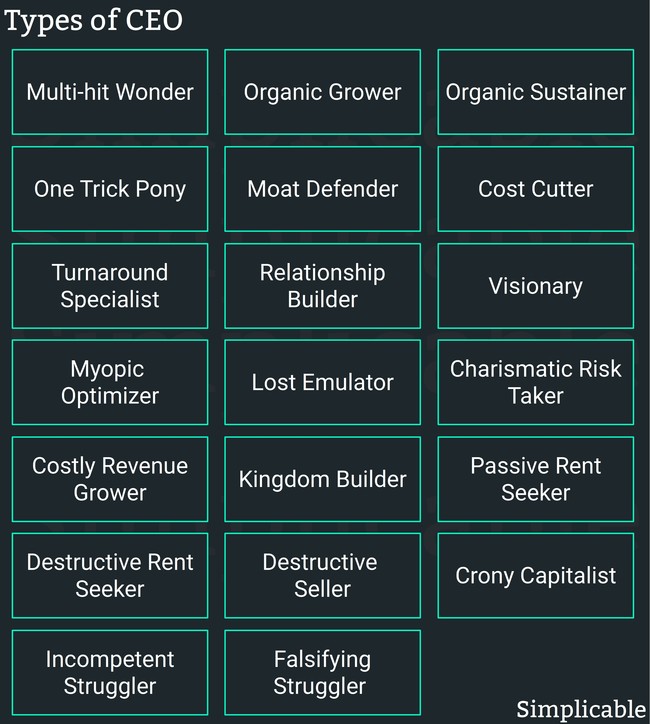

20 Types of CEO  Multi-hit WonderA CEO who is able to achieve sustained organic growth with multiple business models. Allows for extremely high long term rates of return.Organic GrowerGrows a very large business with organic growth and a single business model.Organic SustainerCultivates a resilient business that endures and generates attractive long term returns but doesn't grow beyond a certain size.One Trick PonyA CEO, often a founder, who is able to launch a successful business model but is unable to do a good job operating the firm or growing it beyond the startup phase.Moat DefenderAble to defend an economic moat enjoyed by a dominant firm such as a monopoly but can't achieve organic growth. Buys smaller competitors but does nothing productive with them.Cost CutterOperations specialist who cuts costs and is tough on an organization. Can't achieve meaningful organic growth but at least pushes teams for results. Common in industries with high capital and competition such as airlines. Generally hostile to customers, partners and employees but optimizes.Turnaround SpecialistA CEO who has established a career around making tough decisions. Able to cut entire divisions to save an organization. Unable to do anything about organic growth.Relationship BuilderDevelops valuable relational capital for the firm but isn't good at growing or running the firm. Common at small firms, where a CEO's relationship with major customers and partners may be critical to its success.VisionaryA hands-off CEO who likes to talk to the media. Tends to acquire trendy small companies that they are unable to integrate. A visionary CEO is aloof such that another executive such as a CFO is actually running the firm.Myopic OptimizerA data obsessed CEO who will be successful in optimizing revenue or operational metrics. Has little interest in the big picture and is unable to seize opportunities that aren't immediately measurable. Prone to failures. For example, may seek unit cost reductions until quality completely falls apart and brand value is lost.Lost EmulatorChases trends in the industry and tries to copy competitors. Incapable of original thinking or analysis that would indicate which trends are actually leading to revenue.Charismatic Risk TakerThe charismatic risk taker is able to raise money and has a following of devoted fans. They have some industry insight and are able to achieve organic growth. Uninterested in profits or risk management and likely to shipwreck a firm in the long term.Costly Revenue GrowerAble to grow revenue by spending a lot of money but unable to grow profitable revenue. This is essentially a parlor trick as anyone can grow revenue by spending a lot of money. Common amongst startups whereby a firm with high revenue growth is launched to market based on promises of future profitability that will never materialize because the firm and its business model are fundamentally flawed.Kingdom BuilderAttempts to validate their compensation with mergers and acquisitions that make the firm bigger without improving its long term profits. Unable to achieve organic growth and may damage or destroy a firm to hide this fact.Passive Rent SeekerInterested only in their own compensation but unwilling to damage the firm to achieve this goal. Capable of running a stable business in a mediocre way but will not outperform.Destructive Rent SeekerInterested only in their own compensation and willing to damage the firm to achieve this goal. For example, willing to take on high debt for stock buybacks that allow them to meet revenue targets without actually succeeding in the market.Destructive SellerQuickly destroys value and share price and then sells the organization to another firm. Presents this as a success on their resume and goes on to their next gig where they do the same thing. People may incorrectly assume that an acquisition by a larger firm indicates the CEO was successful in growing the firm.Crony CapitalistMakes friends in high places to allow the firm to rent seek. For example, the CEO of an advertising agency in a corrupt nation with close ties to government that obtains a large number of government contracts under shady circumstances.Incompetent StrugglerHas good intentions but nothing ever seems to work out for them. Often a CEO who reached the position without much competition. For example, a small firm that hires a mid-level executive from a large firm as a CEO.Falsifying StrugglerUnable to grow or run a business such that they are quickly in trouble. Results to falsehoods to delay the inevitable collapse of their firm. This may start small but quickly spirals out of control.Corporate GovernanceThis is the complete list of articles we have written about corporate governance.If you enjoyed this page, please consider bookmarking Simplicable.
ReferencesFoster, R. N. "Creative destruction whips through corporate America." Strategy & Innovation 10.1 (2012): 1-6.Scott D. Anthony, S. Patrick Viguerie, Evan I. Schwartz and John Van Landeghem, 2018 Corporate Longevity Forecast: Creative Destruction is Accelerating, Innosight.GovernanceThe definition of governance with examples.Due Diligence
An overview of due diligence.
AccountabilityThe definition of accountability with examples.
Power StructuresThe common types of power structure.Social Obligation
The definition of social obligation with examples.
Mismanagement
The definition of mismanagement with examples.
Social ResponsibilityAn overview of social responsibility with examples.
Corporate Social Responsibility
An overview of corporate social responsibility with examples.
Organizational ValuesAn overview of organizational value with examples.InvestmentA few articles about investing.Long Squeeze
The common types of long squeeze.
Short Squeeze
The definition of short squeeze with examples.
Business Cycle
The phases and causes of the business cycle.
MicroeconomicsThe definition of microeconomics with examples.
Freeriding
The definition of freeriding with examples.
Precious Metals
An overview of what makes a metal precious including rarity related data.
Smart Money
The definition of smart money with examples.
Dumb Money
The definition of dumb money with examples.
TrendingThe most popular articles on Simplicable in the past day.New ArticlesRecent posts or updates on Simplicable. Site Map
© 2010-2023 Simplicable. All Rights Reserved. Reproduction of materials found on this site, in any form, without explicit permission is prohibited. View credits & copyrights or citation information for this page. |